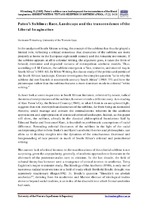| dc.contributor.author | Wittenberg, Hermann | |
| dc.date.accessioned | 2014-02-13T14:08:16Z | |
| dc.date.available | 2014-02-13T14:08:16Z | |
| dc.date.issued | 2005 | |
| dc.identifier.citation | Wittenberg, H. (2005). Alan Paton’s sublime: race, landscape and the transcendence of the liberal imagination. Current Writing: Text and Reception in Southern Africa, 17(2):3-23 | en_US |
| dc.identifier.issn | 1013-929X | |
| dc.identifier.uri | http://hdl.handle.net/10566/1011 | |
| dc.description.abstract | This article develops a postcolonial reading of the sublime by suggesting that aesthetic theories of the sublime were, in their classical philosophical formulations by Edmund Burke and Immanuel Kant, founded on problematic assumptions of racial difference. In the colonial sphere, it is argued, the sublime could discursively manage and contain the contradictions inherent in the aesthetic appreciation and appropriation of contested landscapes. This is particularly evident in the Alan Paton's writing. This article looks at the origins and the influence of rhetoric of the sublime in Paton's work, particularly in his novel Cry, the Beloved Country, and argues that the sublime is a key discursive structure in the shaping of Paton's complex and ambivalent representation of South Africa's politicised and racialised landscape. | en_US |
| dc.language.iso | en | en_US |
| dc.publisher | University of KwaZulu Natal | en_US |
| dc.rights | This is the author's post-print version of an article published by the University of KwaZulu Natal, and may be freely used, provided that full acknowledgement is given. | |
| dc.source.uri | http://dx.doi.org/10.1080/1013929X.2005.9678217 | |
| dc.subject | Paton, Alan | en_US |
| dc.subject | Postcolonial reading | en_US |
| dc.subject | Influence of Rhetoric of Sublime | en_US |
| dc.subject | Cry the Beloved Country | en_US |
| dc.title | Alan Paton’s sublime: race, landscape and the transcendence of the liberal imagination | en_US |
| dc.type | Article | en_US |
| dc.privacy.showsubmitter | false | |
| dc.status.ispeerreviewed | true | |
| dc.description.accreditation | Department of HE and Training approved list | en_US |

